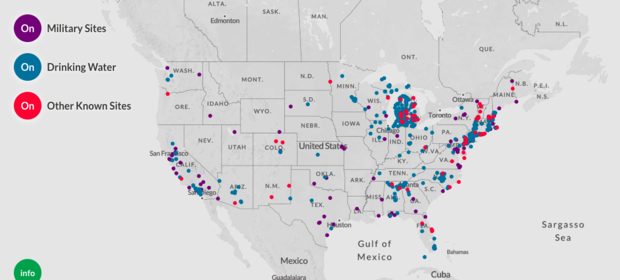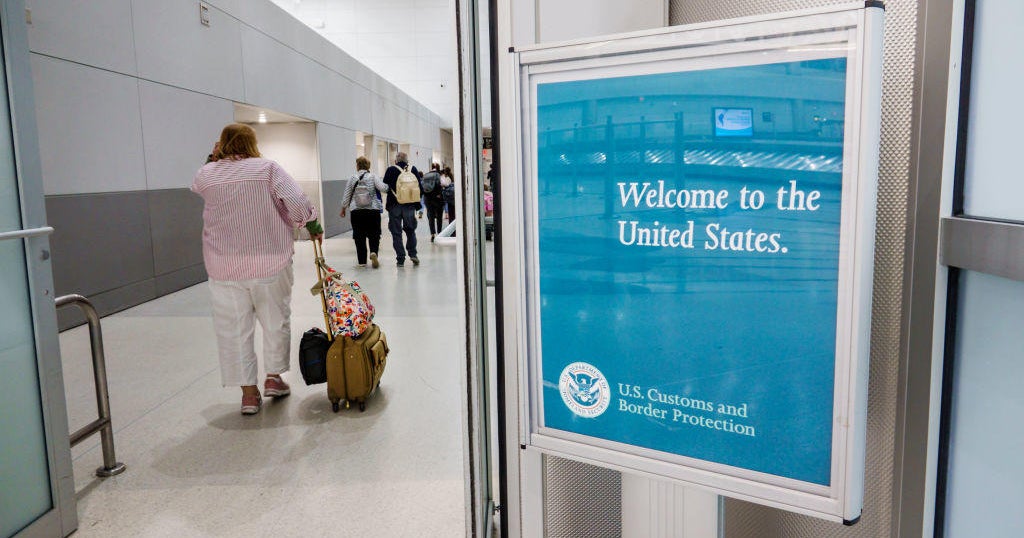New study claims 43 states expose millions to dangerous chemical in drinking water
A new report by the non-profit Environmental Working Group and Northeastern University finds people in nearly every state in the country are exposed to unhealthy drinking water. According to the researchers, 43 states have locations, including drinking water sites, contaminated with PFAS chemicals. The CDC says these chemicals have been linked to health issues that include birth defects, cancers and infertility.
The study compiled information taken from Pentagon data and water utility reports. It shows an estimated 19 million people are exposed to contaminated water. Researchers found at least 610 contaminated locations ranging from public water systems and military bases to civilian airports, industrial plants, dumps and firefighter training sites.
"This should be frightening to all Americans in many ways," David Andrews, a senior scientist for the Environmental Working Group, told CBSN's Anne-Marie Green. "These chemicals... don't break down in our body and they don't break down in our environment and they actually stick to our blood. So levels tend to increase over time."
The Environmental Working Group said in a statement that its interactive map is the most comprehensive resource available to track contamination with a class of chemicals known as PFAS in the United States. According to the Environmental Protection Agency, PFASs are used in a broad range of consumer goods, such as cleaners, textiles, leather, paper and paints, firefighting foams, and wire insulation.
"These chemicals can impact a lot of different health systems, cause numerous health problems, everything from testicular and kidney cancer, heart to the liver, heart to the thyroid," Andrews said, adding that the chemicals can also impact childhood development, low birth weight and immune system health.
"The Environmental Protection Agency has utterly failed to address PFAS with the seriousness this crisis demands, leaving local communities and states to grapple with a complex problem rooted in the failure of the federal chemical regulatory system," said Ken Cook, president of the Environmental Working Group, which has studied these compounds for almost two decades. "EPA must move swiftly to set a truly health-protective legal limit for all PFAS chemicals, requiring utilities to clean up contaminated water supplies."
"The updated map shows that PFAS contamination is truly a nationwide problem, impacting millions of Americans in hundreds of communities," said Phil Brown, a professor of sociology and health sciences at Northeastern University and director of the Social Science Environmental Health Research Institute.
This report comes less than one week after another study by the Environmental Working Group claimed a collection of toxic chemical pollutants found in California drinking water could be responsible for an excess of 15,000 estimated cancer cases over the coming decades. Scientists published that study in the journal Environmental Health after finding toxins and carcinogens in more than 2,700 California community water systems between 2011 and 2015.
A review of drinking water contaminants regulations show the EPA has two categories of drinking water standards: a primary standard which focuses on harmful containments in water, and a secondary standard which focuses on water that causes skin and tooth discoloration and has either poor taste, odor or color.
According to the Environmental Working Group, the EPA does not have a legally enforceable limit for PFAS chemicals in drinking water.
"The EPA has set a health advisory value, but it's not a legal binding limit," Andrews told CBS News. "Part of the problem is they haven't set a new legal drinking water limit for any contaminant in over two decades. The whole system of regulating chemicals that may end up in our water and setting limits is broken and the agency is really falling behind the science here."
His organization is proposing a limit for all PFAS chemicals of 1 ppt, or part per trillion — a much smaller amount than regulators at other agencies have deemed safe.
The Environmental Working Group has sometimes come under fire for its research methods and for warnings that are not in agreement with other global organizations.
In a statement to CBS News, the EPA said in part, "EPA is moving forward with the maximum contaminant level (MCL) process outlined in the Safe Drinking Water Act (SDWA) for PFOA and PFOS. The process prescribed by the Act ensures scientific integrity and transparency when developing regulations for contaminants in public water systems."
The agency released a PFAS Action Plan this year outlining "concrete steps the agency is taking to address PFAS and to protect public health."
The EPA also provided a statement to CBS News about their response to the EWG's interactive map showing detection of PFAS at specific locations:
"EWG's map seems to show any samples for PFAS chemicals that have been collected, which may or may not be detections. Because EPA has not fully reviewed the quality of the underlying data, and based on the agency's commitment to good risk communication with the public, EPA cannot recommend the map be used to determine where public health risks associated with PFAS chemicals may or may not exist. The agency's efforts continue to be focused on taking the actions committed to in the PFAS Action Plan."




